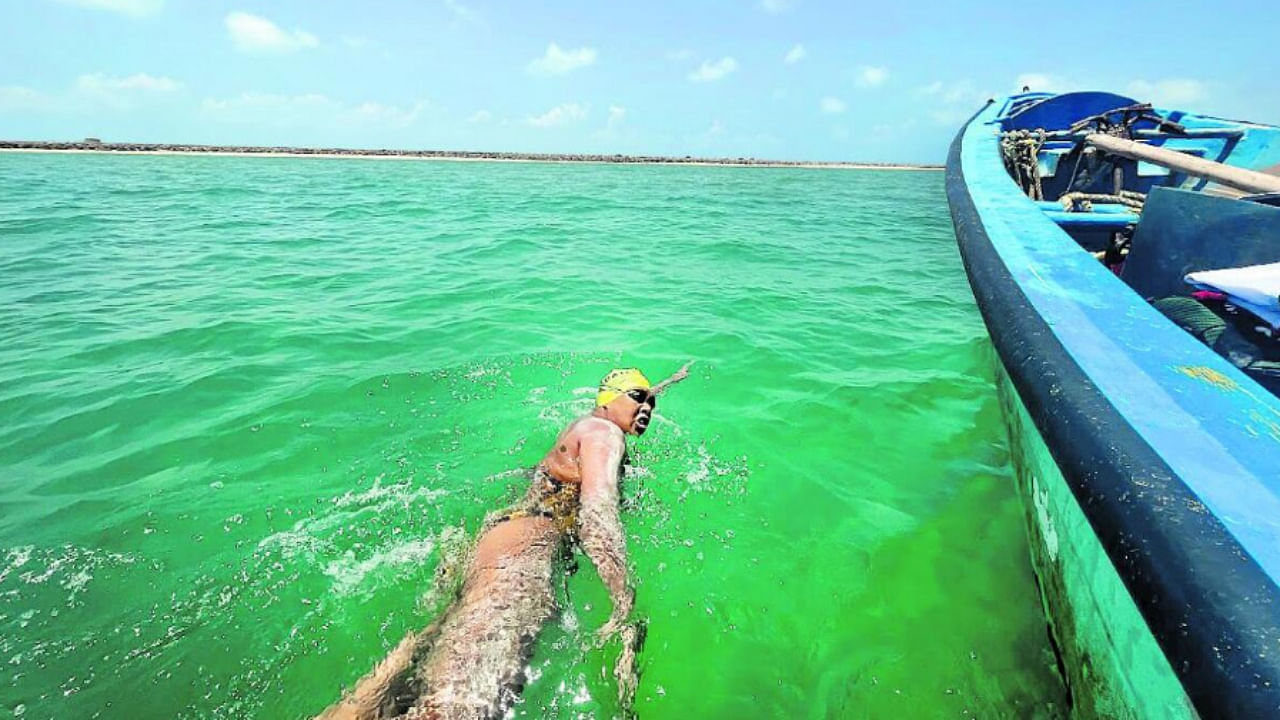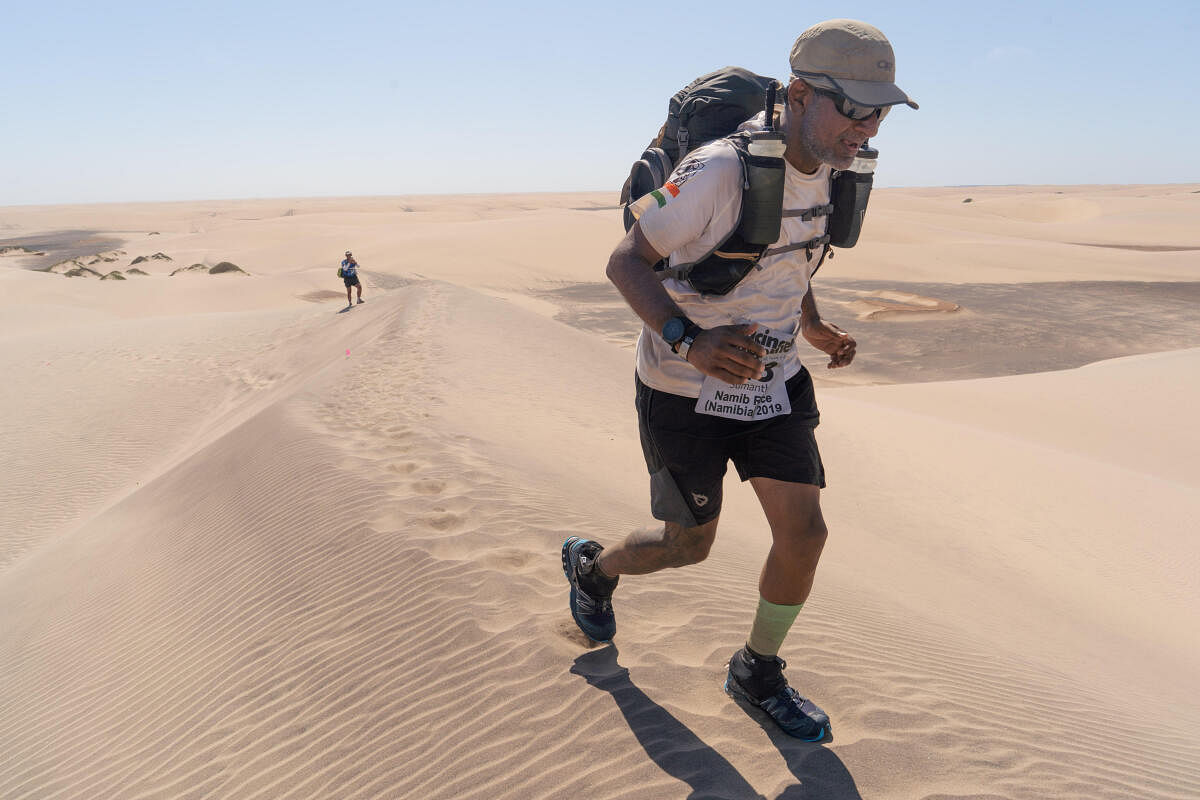

Smeared in white grease to mitigate stings from microbes, Sucheta Deb Burman waded through headwind of 20-25 knots and opposite currents in complete darkness for nine hours across Palk Strait (Bay of Bengal). Topography: Sea. Distance: 62 kms. Time taken: 19 hours 31 minutes.
Already hurting from a shin splint on day three, Sumanth Cidambi, running under the harsh 40-something degree Celsius sun in the Namib (Namibia), had to take a detour that added a few extra kilometres because a pride of lions were resting on the original course. Topography: Desert. Distance: 250 kms. Race duration: Five days.
Unaware of the crevasses and no ropes to use as safety measure, Kieren D’souza crossed an unknown glacier on his way up and down Shara Shuwa South (Himalayas) with limited supplies, not warm enough clothing and without human contact for hours. Topography: Mountain. Distance: 6208m peak. Time taken: 15 hours (approximately).
“Defining moments,” recollect Sucheta, Sumanth and Kieren. They are just three out of a new crop of Indian athletes who are pushing boundaries to test their physical and mental abilities in a sport barely heard of in the country till a few years ago - the ultramarathon.
“It’s simply the innate affection for the outdoors that inspired me,” said Kieren, a full-time ultra runner and endurance athlete who was the first Indian to qualify and finish the 246 km Spartathlon held in Greece in 2016. Not satisfied, he soon combined ultra trail runs with mountaineering to do speed ascents and descents on peaks. Now, climbing up and down Mt Friendship (Manali) in under 12 hours, scaling ten 6000m peaks in 26 days, winning the 111-km race of the La Ultra, among others, is the 30-year-old’s career choice.
The growth spurt of ultras has been nothing short of remarkable. And the reasons are aplenty.
From very few ultra runs with less than 100 participants in each before 2010 in the country, the number of competitions has risen to over 60 in recent times that attracts close to 2000 taking part across events.
While any distance more than a full marathon (42 kms) qualifies as an ultramarathon in running, 30 kms or more is deemed as ultra swimming. These consist of stadium runs, trail runs including high altitude runs, swimathons, open water swims, ironman (triathlon - swim, cycle and run).
And Bengaluru can take pride in revolutionalising this movement by hosting India’s first ever ultra, The Bangalore Ultra (TBU), in 2007 when a conversation between a group of running enthusiasts over a Sunday breakfast at the Airlines hotel shaped into one of the top events.
“Apart from TBU getting bigger and better with each passing year, interest among Indians in the oldest ultramarathon in the world - the Comrades - in South Africa started growing,” explains Sunil Chainani, ultra runner and former manager of the Indian teams. He participated in the first TBU and was among the first 10 Indians to complete the Comrades.
“There were 10 finishers from 14 Indians in 2011 but around 300 had registered in 2019 for the 90 km race between Pietermaritzburg and Durban. Though the sport is by and large dominated by amateurs, it is slowly producing professionals who want to compete rather than do it for the experience and to just finish,” added the 65-year-old, a management consultant who has run over 40 marathons and ultras.
In 2017 India became a member of the International Association of Ultra runners (IAU) and also came under the Athletics Federation of India (AFI) that helped pros finish on the podium at the Asia/ Oceania Championships over the past five years. Ullas Narayan, Deepak Bandbe, Amar Devanda are some of the medallists while the Indian men’s and women’s teams won gold and silver medals respectively in the 24-hour runs at the event in 2019.
Other factors such as the internet, people more conscious about health and fitness, increase in the number of middle and upper middle-class who are able to spend on training, better equipment, manage expenses of travel and competition have contributed in popularising ultras.
“Running started in 2005 to protect my health from diabetics. I completed a few marathons but when I turned 40 in 2010, the obvious question was ‘what next?’. Ultramarathons intrigued me and it was a challenge I wanted to invest my time and energy in,” said 52-year-old Sumanth, who became the third Indian to finish the 4 Deserts Racing The Planet Ultramarathon Series. Considered one of the most grueling events in the sport, it is a series of races in deserts - Sahara race (Egypt/ Jordan/ Namibia), the Gobi March (China/ Mongolia), the Atacama Crossing (Chile) and the Last Desert (Antarctica). A private advisor by profession, he has participated in 18 ultramarathons completing 14 of them including eight 250 kms finishes.
With an upward trend quite evident in running, the progress of ultra swimming, however, hasn’t caught the fancy of the masses on a big scale yet.
“Comparatively we don’t have as many in numbers but interest in open water swims is definitely growing now. In five years we should have several other solo marathon swimmers and hopefully more events,” opined Sucheta, a swim coach and founder of Open Water Swimmers’ Foundation. Apart from becoming the first woman to swim across Palk Strait in March this year, the 39-year-old, in 2019, completed the 81 km Indian National Open Water Swimming Competition in 12 hours held in Murshidabad - which is one of the world’s oldest and longest open water swim events.
Other than competing in organised events, an athlete taking up a challenge of a course comes with the tedious process of procuring permits from government, local authorities and other such logistics. The sport isn’t particularly known to be financially viable either, rather a pinch in the pocket as most of them are self-funded.
That said, such human endeavors in extreme conditions, besides daily regimen of training and diet, eventually boil down to mastering the most important ingredient. The mind.
In the beauty of getting lost in the expanse that comes along with assured pain and loneliness for miles and risking life even, why do these individuals do what they do?
“This is something I’m choosing to do, which by itself is a luxury to have. And I do not want to escape it as both pain and joy are a part of the process. And the hope is to inspire others to venture outdoors. Nature has its way of pushing your true potential as a human. That’s fulfilling,” said Kieren.
“It’s not about mileage numbers, it’s about the high of the experience. We get to run in remote places on the planet that are beautiful. Further, the friendships I have made in this community are for a lifetime,” expressed Sumanth.
Sucheta echoes the same. “Yes it does look like madness to many. But as cliched as it sounds, it is love for what we do. And solitude in uncharted waters is addictive.”
Another calling awaits each of them. Then another will come after. There is always more for the human body and mind to conquer. And the age of the ultra athletes is here to stay.